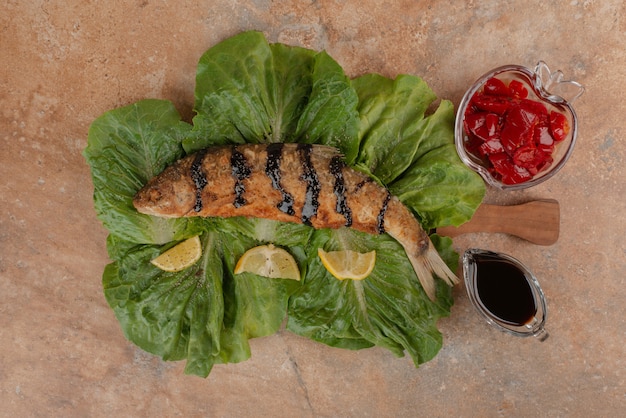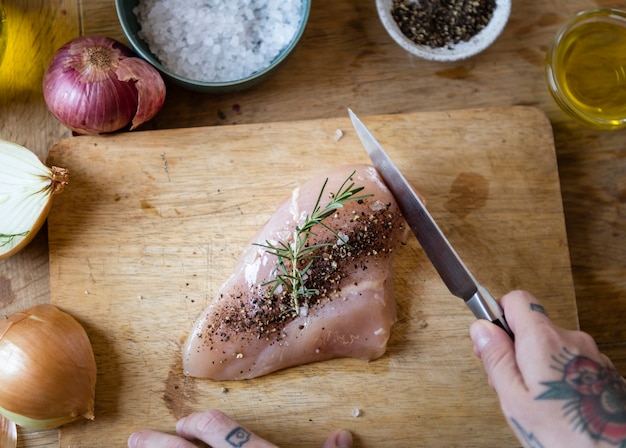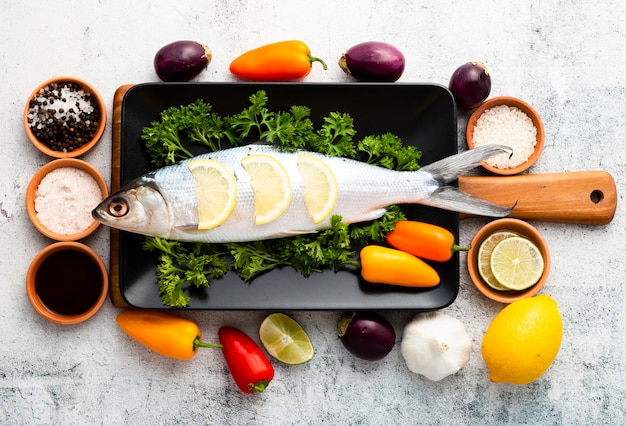As a seasoned home cook, I've always been drawn to the simplicity and versatility of baked tilapia. It's a lean, flavourful fish that's remarkably forgiving, even for culinary novices like myself. But finding the perfect baking time and temperature for that flaky, juicy, and perfectly cooked tilapia can be a bit of a puzzle, especially for those of us who tend to overcook things (guilty as charged!). No one wants a dry, overcooked fish, right? So, I embarked on a culinary quest to unlock the secrets of baking tilapia at 350 degrees fahrenheit (175 degrees Celsius).
And let me tell you, it's been a delicious journey! I've experimented with different techniques, sizes of tilapia fillets, and even different ovens, all in the pursuit of the ultimate baked tilapia. Now, I'm delighted to share my discoveries and insights with you in this comprehensive guide. I'll break down everything you need to know to bake tilapia to perfection, from selecting the right fillet to recognizing those telltale signs of a perfectly cooked fish. So grab your favourite mug, brew a cuppa, and let's dive into the world of tilapia baking!
Part 1: Choosing Your Tilapia

The first step in creating a delicious tilapia bake is selecting the right fish. The quality of your tilapia will significantly impact the final dish, so it's worth taking a moment to choose wisely. Here's what to keep in mind:
1. Freshness is King:
If you can, opt for fresh tilapia fillets. They'll have a slightly sweet, fresh scent and a firm, springy texture. The smell should remind you of the sea, not anything overly fishy or strong. However, frozen tilapia can be a good alternative if fresh isn't available. Just make sure it's frozen solid and doesn't have any ice crystals on it. This means it's been properly frozen and is likely to have a better texture. When buying frozen, choose fillets that are individually wrapped, and check the expiration date.
2. Size Does Matter:
The size of your tilapia fillets will influence the baking time. Smaller fillets (about 4-6 ounces) will cook faster than larger fillets (8-10 ounces). It's like cooking a thin steak versus a thick one – the thicker the cut, the longer it takes to cook through. If you're working with a mix of sizes, it's a good idea to bake the smaller fillets for a shorter time and the larger ones for longer. This ensures that all your fillets are cooked to perfection.
3. Skin On or Skin Off:
Both skin-on and skin-off tilapia fillets work well for baking. Skin-on fillets will help retain moisture, creating a juicier fish. The skin itself adds a bit of flavour and crispness. Skin-off fillets offer a slightly quicker cook time, making them a good option if you're short on time. I personally prefer skin-on fillets for their flavour and texture, but it's entirely up to your preference. If you're not sure, you can always try both and see which you like better!
Part 2: Prepping Your Tilapia

Once you've chosen your tilapia, it's time to get ready to bake. Here are some pre-baking tips to help your tilapia turn out amazing:
1. Pat It Dry:
Before seasoning your tilapia, pat it dry with paper towels. This will help ensure a nice crisp skin and prevent the fillets from steaming instead of baking. You want a lovely golden-brown colour on the skin, not a soggy mess!
2. Season It Up:
Seasoning is where you can really let your culinary creativity shine. A simple sprinkle of salt and pepper is always a classic, and often all you need to let the natural flavour of the fish shine. But if you're feeling adventurous, you can experiment with other herbs and spices. For a flavour explosion, try a combination of paprika, garlic powder, onion powder, and lemon zest. This combo adds a beautiful depth of flavour and a touch of brightness. Don't be afraid to experiment with different flavour combinations!
3. Marinate for Extra Flavour:
If you have time, marinating your tilapia before baking will add an extra layer of flavour and tenderness. I like to use a simple marinade of olive oil, lemon juice, and herbs like rosemary or thyme. Marinating for at least 30 minutes will do the trick, but a longer marinade (up to a few hours) will produce even more intense flavour. This is especially helpful if you're using frozen tilapia as it can help to rehydrate the fish.
Part 3: Baking Your Tilapia

Now, we're getting to the heart of the matter! Baking your tilapia is a breeze, but there are a few key factors to keep in mind to ensure a perfect outcome.
1. Oven Temperature:
For the best results, bake your tilapia at 350 degrees Fahrenheit (175 degrees Celsius). This temperature will cook the fish evenly without drying it out. It's a happy medium that allows the fish to cook through while retaining its moisture.
2. Baking Dish Choice:
You can bake your tilapia in a variety of dishes, from a simple baking sheet to a glass casserole dish. If you're using a baking sheet, be sure to line it with parchment paper for easy cleanup. This will also prevent the tilapia from sticking to the pan. For a casserole dish, grease it lightly with olive oil or cooking spray to prevent sticking. No one wants to scrape off burnt fish!
3. Baking Time:
The baking time will vary depending on the thickness of your tilapia fillets. Here's a general guideline:
Baking Time at 350 Degrees Fahrenheit (175 Degrees Celsius):
| Fillets Size | Baking Time |
|---|---|
| 4-6 ounces | 12-15 minutes |
| 8-10 ounces | 18-20 minutes |
Remember, these are just general guidelines. The best way to determine if your tilapia is cooked through is by using a food thermometer. Insert the thermometer into the thickest part of the fish. The tilapia is cooked when the internal temperature reaches 145 degrees Fahrenheit (63 degrees Celsius).
Part 4: Signs of a Perfectly Baked Tilapia
Knowing when your tilapia is perfectly cooked is crucial. Here's what to look for:
1. The Flake Test:
If you gently press on the tilapia with a fork, it should flake easily. This means the fish is cooked through and ready to be enjoyed. The flakes should be firm and white, not mushy or translucent.
2. The Colour Change:
The tilapia will change colour as it cooks. The flesh will turn from a translucent white to an opaque white. You may also notice that the skin becomes slightly browned. This indicates that the fish has been cooked evenly and is safe to eat.
3. The Smell Test:
A cooked tilapia will have a mild, slightly sweet aroma. If you smell a fishy or ammonia-like odour, it means the fish is not fresh or has been overcooked. The smell should be pleasant and inviting, not overpowering or off-putting.
Part 5: Serving Your Baked Tilapia
Congratulations! You've successfully baked a delicious tilapia. Now, it's time to enjoy the fruits of your labour. Here are some tips for serving your baked tilapia:
1. Serve It Hot:
To enjoy the tilapia's best flavour and texture, serve it immediately after it comes out of the oven. The fish is at its best when it's hot and flaky. Serve it while it's still sizzling!
2. Pair It With Sides:
Tilapia pairs well with a variety of sides, offering endless possibilities for a delicious meal. Some popular choices include:
- Roasted vegetables, such as broccoli, asparagus, or Brussels sprouts. Roasted vegetables add a touch of earthy sweetness and a satisfying texture contrast.
- A simple salad with a vinaigrette dressing. A light and refreshing salad complements the richness of the fish.
- Rice or quinoa. These grains provide a hearty base for your meal.
- baked potatoes or sweet potatoes. A creamy baked potato or sweet potato adds a touch of indulgence to your dish.
- Pasta with a light sauce. Pasta with a simple lemon-herb sauce or a light tomato sauce creates a satisfying and flavorful combination.
3. Add a Squeeze of Lemon:
A squeeze of fresh lemon juice will brighten up the flavour of your tilapia and add a touch of acidity to balance out the richness of the fish. It's a simple but effective way to enhance the flavour profile of your dish.
Part 6: Storing Leftover Tilapia
If you have any leftover baked tilapia, it can be stored in the refrigerator for up to 3 days. To reheat, you can microwave it on a low setting for about 30 seconds. You can also reheat it in the oven at 350 degrees Fahrenheit for about 5-10 minutes. Remember to let it cool slightly before serving to prevent burning your mouth.
Part 7: Troubleshooting Baking Tilapia
Even with this comprehensive guide, things don't always go as planned. Here are some common problems you might encounter while baking tilapia and how to solve them:
1. Overcooked Tilapia:
The main sign of overcooked tilapia is dryness. The fish will feel rubbery and have a slightly tough texture. To avoid overcooking, bake your tilapia for a shorter time and use a food thermometer to check its internal temperature. If you suspect it might be overcooked, remove it from the oven a few minutes earlier than suggested.
2. Undercooked Tilapia:
Undercooked tilapia will be translucent and have a raw, fishy smell. You can remedy this by baking the fish for a few more minutes, checking its temperature with a food thermometer. If you see any translucent areas, bake it for a few more minutes.
3. Sticking Tilapia:
Tilapia can stick to the baking dish if it's not greased properly. To prevent sticking, grease your baking dish lightly with olive oil or cooking spray before placing the fish inside. You can also use parchment paper to line your baking sheet, which will make cleanup a breeze.
Part 8: Getting Creative With Your Tilapia
Now that you have a solid understanding of baking tilapia, it's time to unleash your creativity! Here are a few ideas for jazzing up your tilapia bake:
1. Try Different Marinades:
Experiment with different flavours and combinations for your tilapia marinade. Citrus, garlic, herbs, and spices are all great options. You can also try marinating your tilapia in yogurt or buttermilk for a tender and tangy flavour. Remember, the possibilities are endless!
2. Add Toppings:
Top your baked tilapia with your favourite ingredients to create a flavourful and satisfying meal. Some popular toppings include:
- A sprinkle of fresh herbs. A sprinkle of parsley, dill, or cilantro adds a burst of freshness and aroma.
- A dollop of pesto. Pesto adds a savory and herbaceous flavour.
- A slice of lemon. Lemon adds a bright citrus flavour and helps to balance the richness of the fish.
- A drizzle of olive oil. Olive oil adds a richness and depth of flavour.
- Crushed almonds or sesame seeds. Nuts or seeds add a satisfying crunch and a nutty flavour.
3. Bake Tilapia in Foil Packets:
Baking tilapia in foil packets creates a moist and flavorful dish. Simply place the tilapia fillets in foil packets with your favourite vegetables and seasonings, then bake them in the oven. The steam created in the packets will help to cook the fish evenly and lock in the flavour. This is a fantastic way to create a complete meal in one packet!
Part 9: FAQs
I've answered a lot of common questions about baking tilapia in this guide, but I'm sure you have even more! Here are a few frequently asked questions that you might find helpful:
1. Can I bake tilapia with the skin on?
Yes, you can bake tilapia with the skin on. The skin will help to keep the fish moist and add a bit of extra flavour. Just make sure to score the skin a few times with a knife to prevent it from curling up during baking. This helps to ensure even cooking and prevents the skin from becoming tough.
2. Can I bake frozen tilapia?
Yes, you can bake frozen tilapia. Simply thaw the fillets in the refrigerator overnight before baking. Make sure the fillets are completely thawed before placing them in the oven. Thawing them in the refrigerator ensures that the fish thaws evenly, reducing the risk of undercooked areas.
3. What if my oven doesn't have a temperature gauge?
If your oven doesn't have a temperature gauge, you can use an oven thermometer to check the accuracy of your oven's temperature. This will help you bake your tilapia at the correct temperature and ensure that it cooks evenly. You can purchase an oven thermometer online or at most kitchen stores.
4. Can I bake tilapia with other ingredients?
Absolutely! You can bake tilapia with other ingredients, such as vegetables, herbs, and spices. Get creative and experiment with different combinations. Adding vegetables like bell peppers, onions, or zucchini adds flavour and nutrients to your meal.
5. Can I freeze baked tilapia?
It's best not to freeze baked tilapia, as it can become dry and crumbly. If you need to store it for a longer period, it's better to freeze the raw tilapia before baking it. Freezing cooked fish often results in a less desirable texture.
I hope this guide has been helpful in demystifying the art of baking tilapia. Remember, practice makes perfect! The more you bake tilapia, the more confident you'll become in the kitchen. So don't be afraid to experiment, try new recipes, and most importantly, have fun! Happy baking!
Everyone is watching

Perfect Rice Every Time: The Ultimate Guide to Cooking Rice
Cooking TipsAs a self-proclaimed foodie, I've always been a bit obsessed with rice. It's the foundation of countless cuisi...

The Ultimate Guide to Cooking Asparagus: Tips, Techniques, and Recipes
Cooking TipsAsparagus. The mere mention of this spring delicacy conjures up images of vibrant green spears, crisp and burs...

Ultimate Guide to Cooking the Perfect Thanksgiving Turkey
Cooking TipsThanksgiving. Just the word conjures up images of overflowing tables laden with delicious food, the scent of r...

Prime Rib Roast Cooking Time Chart: Per Pound Guide
Cooking TipsPrime rib roast. Just the name conjures images of lavish dinners, crackling fires, and hearty laughter. It’s ...

Can You Cook Spaghetti with Gasoline? (The Shocking Truth)
Cooking TipsWe've all seen those crazy internet trends. You know, the ones that make you wonder, "Did someone actually try...
